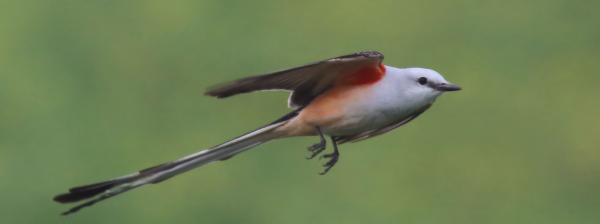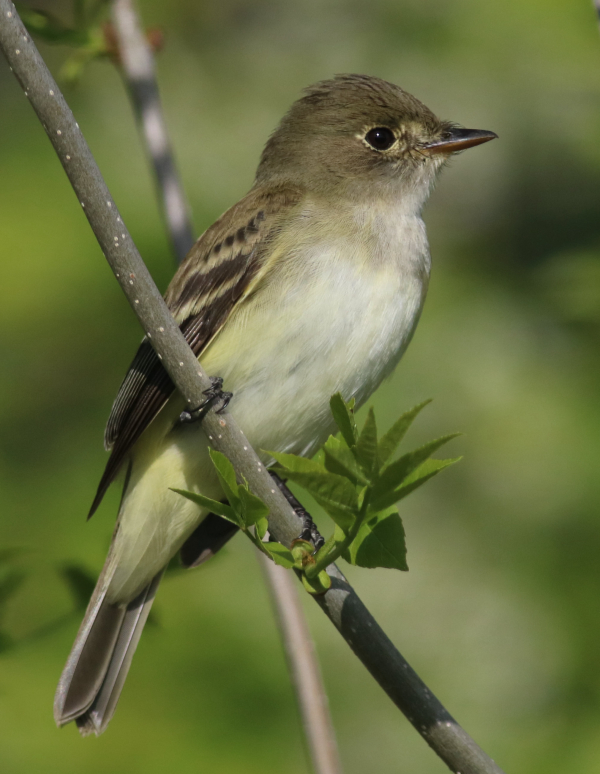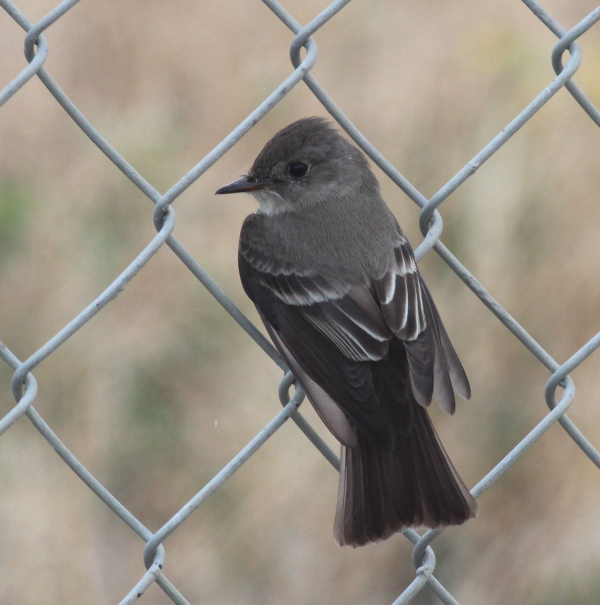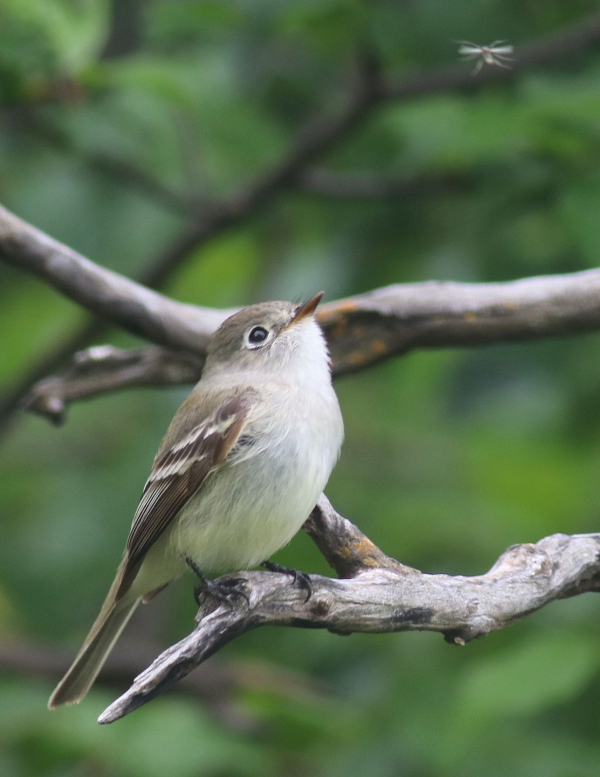
This Vermillion Flycatcher provided a surprise opportunity to photograph it perched and as it made flights to intercept flying insects that passed by. It worked fairly well to concentrate on trying to photograph the red bird as it returned to the same perch, yielding 3 good action photos.
|
Flycatchers come in many shapes and colors, but for the most part, it’s relatively easy to determine what’s a flycatcher and what’s not. Identifying the species of some of the small “Empid” flycatchers can be a much tricky proposition. Some may be known by different names, like the kingbirds or kiskadees, but watch them for a moment and it’s clear they are flycatchers too. They all tend to be dynamos with a focus on hunting insects from a perch, often flying out to catch a bug on the wing, often returning to the same perch. That behavior is referred to as “hawking” insects, and it’s a boon to photographers who wish to photograph flycatchers in action.
If you find a flycatcher hunting, and can approach relatively close to the flycatcher’s perch, you will usually be in position to take a series of photos of the flycatcher. If it repositions, wait a bit, watching its activities, but it’s a good bet the bird will return to the perch you approached in time. If not, try to reposition to photograph the flycatcher perched and in flight. As with any photo opportunity, be aware of the direction of the sunlight, as you position for flycatcher photos keep the sun behind you and the bird in front of you, with your shadow pointing at the flycatcher – ideally.
Most flycatchers are pretty accommodating, not to concerned with people; move slowly and give them some extra space, and you will eventually get into position. But it can be a good workout for you as a photographer, as well as for your equipment, to get a good flight photo of any flycatcher. If you have a bird that is returning to the same perch repeatedly, your best bet may be to concentrate on when the bird returns to the perch. The resulting photos can be especially impressive, with the bird stretching its legs toward the perch with its wings spread behind it.

Foto Flurry
In these cases it is best to take a flurry of photographs using the “Continuous Drive Mode” setting on your camera. I usually keep this as my standard setting rather than the single photo mode; you can still take a single photo, or 2 photos at a time as you get familiar with the reaction of the shutter button in this continuous drive mode. Of course, if you hold the shutter button down, you will take from 3 to 10 photos per second (depending on your camera), which is a boon to taking split-second photos of birds in flight.

An impressive portrait of a tiny Least Flycatcher. An f7 aperture blurred most of the background vegetation, which helped to emphasize the bird.
|
All that gives you a good chance of getting a fine photo or 2, or a few, but it’s harder than it sounds. Most flycatchers are pretty small, and they are very fast, so it takes some skill, some practice, and some luck to get some flycatcher flight fotos. Just keeping the small, quick birds in the photo frame is a challenge, and it takes some anticipation to take photos before the bird lands. But you will get accustomed to it, miss a few photos and get a few; bird photography is rarely a 100 percent prospect, and trying a number of times makes each opportunity all the more enjoyable, and hopefully, successful.
There are a couple other things to keep in mind, like shutter speed and aperture. You probably want to stop the action of the bird in flight, which will take a fast shutter speed – say 1/1000 or faster. On a sunny day, my go-to settings are an ISO of 400, an aperture of f8 and with my camera set to “Aperture Priority Mode,” I get plenty of shutter speed. But with a small bird like most flycatchers, you may not need an f8 aperture, and may wish to blur the background out of focus, making an f6 a better setting.

Although natural perches are usually preferred for bird photos, sometimes you work with what you get, and a case could be made that the chain link mosaic adds an element of interest to this Western Wood Peewee image.
|
As always, be aware of the background behind the flycatcher’s perch and see if you can take a step right or left or backward to eliminate distracting background vegetation. Ideally, any plants will be some distance from the perch so the f6 setting will blur the background and emphasize the sharp flycatcher. But if the bird is surrounded by vegetation, that can be pleasing too, and natural. When you are in position, you may want to do a little second guessing to get the most out of any photo session with a given flycatcher, and even a little research by changing a setting to try to improve the process.
Flycatcher Portraits Too
Of course, it’s not necessary to concentrate on photographing flying flycatchers; these little dynamos make great portrait subjects too, as long as they hold still. Flycatchers are usually on the go, and quick to chase the next flying insect, or to repel another flycatcher that enters its feeding territory.
One thing to keep in mind is the perch itself. After you take a few documentary photos of a species, you tend to look for a trophy photo, a classic view of a given flycatcher. As a rule, many flycatchers tend to favor wires and metal fences to launch their aerial assaults from. I tend to try to avoid photographing birds on these perches, and prefer a natural branch or twig to a barbed wire fence or an electric wire. That’s my usual inclination, but everyone has their preferences, and I have been known to overemphasize a metal look by using a chain-link fence as a setting for a flycatcher portrait.

Another Least Flycatcher eyes a flying mosquito a split second before take-off. The different opportunities that flycatchers present for photographers are myriad, and should inspire us to make an extra effort to document their activities.
|
Flycatchers are often overlooked birds as photo subjects, but they can provide photographers excellent photo opportunities in the field. They are not always the easiest birds to photograph, but challenging birds are part of what makes bird photography so interesting. Eventually, you can build up a library of flycatcher photographs that add dimension to your photo files and variety to the images you utilize and share.
March is here! Make it a memorable month through the spring photos you take. Give your camera a good workout, and enjoy the fresh air with the change of seasons. Good Luck!
Article and photographs by Paul Konrad
Share your bird photos and birding experiences at editorstbw2@gmail.com